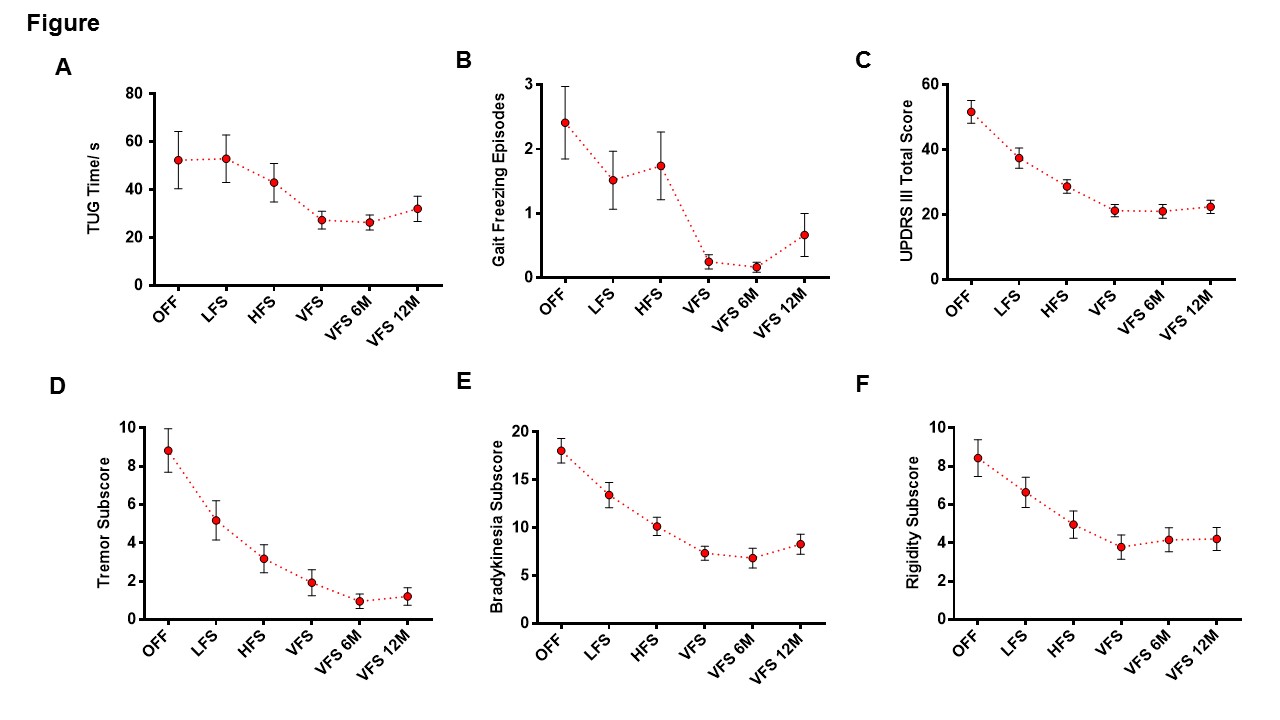Session Information
Date: Thursday, June 8, 2017
Session Title: Parkinson’s Disease: Clinical Trials, Pharmacology And Treatment
Session Time: 1:15pm-2:45pm
Location: Exhibit Hall C
Objective: To determine the effects of a novel deep brain stimulation (DBS) paradigm of combining high and low frequency stimulation in varying patterns (VFS) for freezing of gait (FOG) and appendicular motor symptoms in Parkinson’s Disease (PD).
Background: DBS is a well-established therapy for PD and is conventionally delivered in a high frequency range (130-180 Hz, HFS). HFS DBS is found to have suboptimal effects on FOG symptoms. Low frequency stimulation (60-80 Hz, LFS) is an alternate option however the benefits are noted as transient, inconsistent and may not have effective control of appendicular motor symptoms. We sought to examine the effects of a novel frequency based (VFS DBS) programming.
Methods: Twenty-eight PD patients (16 males, 12 females) with bilateral STN DBS (PINS system) were enrolled. These patients were optimized on HFS therapy for control of tremor, rigidity and bradykinesia however complained of a persistent FOG. Unified PD Rating Scale (UPDRS) and a 10 meter timed up and go (TUG) task was used for comparisons while patients received one hour of HFS, one hour of LFS and one hour of VFS therapy. All evaluations (off dopaminergic medications) were performed by blinded video raters. These patients were sent home on VFS and followed-up at 6 and 12 months. Repeated measures ANOVA and post hoc comparisons with Bonferroni corrections were performed.
Results: Total time on the TUG task with VFS (27.4 seconds) was significantly lower compared to HFS (43.0 seconds, p = 0.005) and LFS (53.0 seconds, p = 0.005) therapy (Fig. A). Similarly, the number of freezing episodes significantly reduced with VFS (0.3 episodes) compared to HFS (1.7 episodes, p = 0.004) and LFS (1.5 episodes, p = 0.004) (Fig. B). VFS DBS also significantly reduced tremors (HFS, p = 0.005; LFS, p = 0.001) (Fig. D), improved bradykinesia (HFS, p = 0.001; LFS p = 0.001) (Fig. E) and rigidity (HFS, p = 0.001; LFS, p = 0.001) (Fig. F). The VFS effects on gait and motor outcomes remained sustained at 6 and 12 months follow-up (Fig.).
Conclusions: A combination of HFS and LFS DBS effectively controls gait as well as appendicular motor symptoms in PD. VFS benefits are noted to remain sustained at one year follow-up. A larger follow-up study is required to further confirm these results.
To cite this abstract in AMA style:
F. Jia, A. Wagle Shukla, w. Hu, L. Almeida, M. Okun, L. Li. A novel paradigm of variable frequency deep brain stimulation to improve freezing of gait in Parkinson’s disease [abstract]. Mov Disord. 2017; 32 (suppl 2). https://www.mdsabstracts.org/abstract/a-novel-paradigm-of-variable-frequency-deep-brain-stimulation-to-improve-freezing-of-gait-in-parkinsons-disease/. Accessed January 2, 2026.« Back to 2017 International Congress
MDS Abstracts - https://www.mdsabstracts.org/abstract/a-novel-paradigm-of-variable-frequency-deep-brain-stimulation-to-improve-freezing-of-gait-in-parkinsons-disease/

